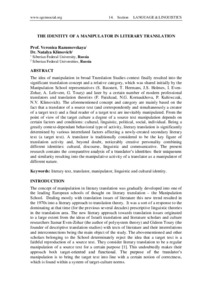THE IDENTITY OF A MANIPULATOR IN LITERARY TRANSLATION
URI (для ссылок/цитирований):
https://sgemworld.at/ssgemlib/spip.php?article5360https://elib.sfu-kras.ru/handle/2311/110632
Автор:
Разумовская Вероника Адольфовна Климович, Наталья Викторовна
Коллективный автор:
Институт экономики, управления и природопользования
Кафедра делового иностранного языка
Дата:
2017-10Журнал:
4th International Multidisciplinary Scientific Conference on Social Sciences and Arts SGEM 2017Квартиль журнала в Web of Science:
без квартиляБиблиографическое описание:
Разумовская Вероника Адольфовна Климович, Наталья Викторовна. THE IDENTITY OF A MANIPULATOR IN LITERARY TRANSLATION [Текст] / Наталья Викторовна Разумовская Вероника Адольфовна Климович // 4th International Multidisciplinary Scientific Conference on Social Sciences and Arts SGEM 2017: Science and Art. — 2017. — Т. 3 (№ 2). — С. 1115-1122Текст статьи не публикуется в открытом доступе в соответствии с политикой журнала.
Аннотация:
he idea of manipulation in broad Translation Studies context finally resulted into the significant translation concept and a relative category, which was shared initially by the Manipulation School representatives (S. Bassnett, T. Hermans, J.S. Holmes, I. Even-Zohar, A. Lefevere, G. Toury) and later by a certain number of modern professional translators and translation theorists (F. Farahzad, N.G. Kornaukhova, P. Kuhiwczak, N.V. Klimovich). The aforementioned concept and category are mainly based on the fact that a translator of a source text (and correspondently and simultaneously a creator of a target text) and a final reader of a target text are inevitably manipulated. From the point of view of the target culture a degree of a source text manipulation depends on certain factors and conditions: cultural, linguistic, political, social, individual. Being a greatly context-dependant behavioral type of activity, literary translation is significantly determined by various interrelated factors affecting a newly-created secondary literary text (a target text). A translator is traditionally considered to be the key figure of translation activity and beyond doubt noticeably creative personality combining different identities: cultural, discourse, linguistic and communicative. The present research contains the comparative analysis of a translator’s identities: their uniqueness and similarity resulting into the manipulative activity of a translator as a manipulator of different nature.

